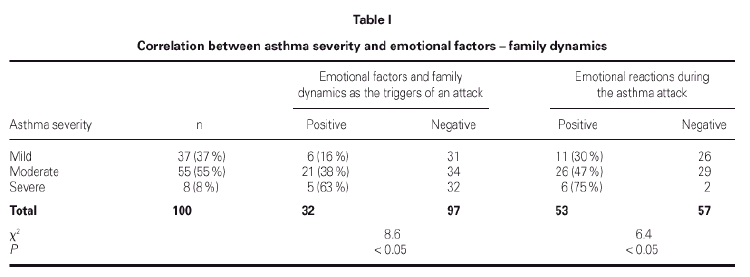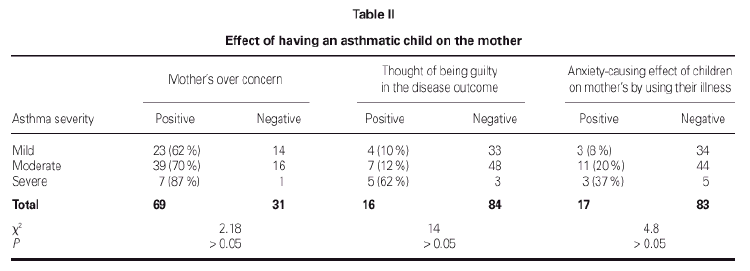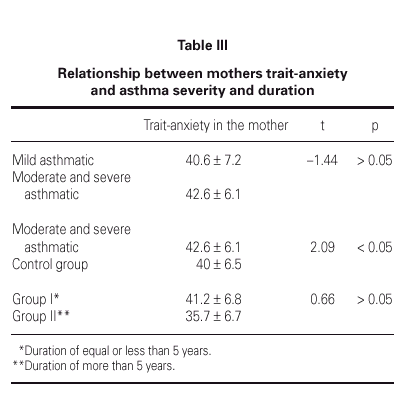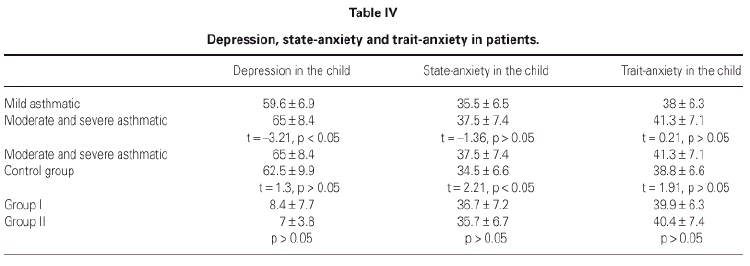INTRODUCTION
Asthma is a chronic respiratory disorder characterized by recurrent episodes of impaired breathing when the airways become obstructed1. This disease causes some psychological problems due to its early onset, hospitalization requirement of some attacks, long-term medication usage and restricted social life. The family, especially the mother, may show some psychological problems because of the early onset of symptoms, being under an obligation to provide the compliance of the child to the treatment, her wish to control all of the social and physical activities of the child and the burden of economical problems2,3. In some studies it is shown that, psychosocial stress factors and anxiety among the family members can provoke the asthmatic attacks. On the contrary some other studies declare that both children and adults can cope with the psychological effects of the disease4,5 This aspect of the disease is still unclear in spite of many investigations since 1960s, however in all fairness there is no enough study on this subject in Turkey. For this purpose, it is needed to investigate the role of psychosocial factors on the exacerbations and the severity of the disease in asthmatic patients, the relations between the child, the mother and the family, the probability of the mother's anxiety and the psychological problems in the asthmatic patients mothers and the healthy control group.
MATERIALS AND METHODS
The study group included 100 patients aged between 6 to 16 years who were diagnosed as bronchial asthma and followed in the Cerrahpa şa Medical Faculty, Pediatric Allergy and Immunology Department for at least 6 years and their mothers. Fifty children of the same age group and their mothers, who were admitted to our general pediatric clinics and having no chronic illness, were selected as our control group. Sixty-seven percent of the asthmatic patients were boys and 33 % were girls. Fifty four percent of the control group were boys and 46 % were girls. The mean age of both groups was 10.2 ± 2. The spectrum of disease severity in the study group was as follows: 37 % mild, 55 % moderate and 8 % severe asthmatics. The patients were divided into 2 groups according to the duration of the disease: first group was of a duration of equal or less than 5 years; and the second group of more than 5 years. To investigate the presence of depression or anxiety in the asthmatic children, we applied some tests, which were proved to be reliable internationally. A translated version of Achenbach Child Behavior Check list of 4-5, 6-11, 12-16 aged boys and girls was used in the assessment of children's behavior6,7. The checklist is a graded one, aiming the assessment of the children's behavior in the last 6 months, answered by mothers, fathers or the patients themselves. The questionnaire comprises 118 behavior items, which the parents and/or children grade by 0(never), 1(sometimes) or 2(mostly/often).
Depression was determined by T score, which the child had gained by his behavioral disorders. T score was defined by the severity of asthma and the comparison of the asthmatic child and the healthy control group. Trait and state anxiety scales contain two criterions, which consists of twenty items. State anxiety scale requires the statement of the child of how he feels himself at symptomatic times and conditions. On the other hand, trait anxiety scale requires the statement of the child of how he feels himself usually.
According to the severity of the feelings or behavior the scale was designed as: l-almost never, 2-sometimes, 3-usually and 4-almost every time. The asthmatic children were compared with the healthy controls in respect of state and trait anxiety and also the severity of asthma. The mothers of the asthmatic children were evaluated by the severity of asthma and they were also compared to the mothers of the control group according to the state anxiety.
The same person talking to both the mother and the child face to face and informing the required aspects of them filled in a patient information form. This form was aimed to investigate the effect of emotional factors and family dynamics on the asthma attack provocation, the emotional reactions of the child during the attack and the impression of having an asthmatic child on the family.
The following questions were asked to clear the effects of emotional factors and family dynamics as triggers of the attack.
Does the attack start or the symptom aggravate with reactions such as fear, anxiety, excitement, grief, frustration and panic?
Does the child accept the dyspnea as a punishment for his/her fault?
Does the patient use his/her illness as a weapon to fulfill his/her wishes?
Is there any problem between the mother and the child?
Does the patient show any frustration to his/her mother?
Is there any problem between the parents?
Was the child separated from his/her mother or father?
The following questions were asked for the presence of emotional reactions:
Are there extreme fear, excitement and anxiety?
Does the patient feel panic?
Dose the patient think that he/she will die because of his/her illness?
Does the patient exaggerate his/her illness?
Is the patient's compliance to treatment enough or not?
In the presence of two or more emotional factors and family dynamics mentioned above, the result was evaluated as positive. All the data were analyzed by using SPSS. The frequencies of depression and anxiety of the mother and the child were analyzed by student t test and the other analyses were assessed by Chi-square test. Differences were considered significant at p < 0,05.
RESULTS
Emotional factors and family dynamics were found to be trigger factors for disease attacks in 16 % of mild, 38 % of moderate and 63 % of severe asthmatic patients (table I, p < 0,05). The role of emotional factors on triggering of an attack or increase in the severity of the symptoms was seen to be significant. It was found that by the disease severity these effects increased in a rate of 30 % in mild, 47 % in moderate and 75 % in severe asthmatics.
The mother's over concern on the asthmatic children were investigated to clear the effects of having an asthmatic child on mothers up. The mothers of 62 % of mild, 70 % of moderate and 87 % of severe asthmatic children were found to be in an over concern behavior in a significant rate. When the other psycho-pathological changes observed in the mothers were investigated, there was found that in the severe asthmatic group the frequency of the mothers who believed that the reason of the disease was their own fault was found to be higher than the other groups (table II, p < 0,05). No significant difference was noticed between the severity groups in respect to the children's making their mothers feel anxious by using their illness (table III, p < 0,05).
There were not significant differences in frequency of the mothers' anxiety between the disease severity groups (p > 0,05). The frequencies of anxiety were found significantly higher in mothers of patients with moderate and sever asthma than the control groups (p < 0.05). The relationship between duration of the disease and mothers' anxiety was not significant (table III, p > 0,05).
The data on depression, state-anxiety and trait-anxiety in a sick-child investigated for the psychological effect of the disease is seen in table IV. In moderate and severe asthmatic groups the frequency of depression was found to be significantly higher than the mild asthmatic group (p < 0,05). There was no significant difference between the asthmatic groups in respect of state and trait-anxiety (p > 0,05, table IV). The frequencies of depression in moderate and severe asthmatic children were not so different from frequency of the control group (p > 0.05). Similarly, the frequencies of trait anxiety in these groups were not so different from the control group's frequency. But the state-anxiety of these groups was significantly more frequent than that of control group (p < 0.05). It was found that there was no effect of the disease duration on the depression and anxiety.
DISCUSSION
It is not clearly known whether the psychosocial stress factors are the cause or the result of the asthma. Some psychopathologies may develop both in the asthmatic patients themselves and their close-contact families. It is stated that some intense emotional responses such as fear, anger, and excitement provoke asthma attacks in 40 % of patients5.
It has been shown that asthma incidence is higher in children of insufficient family care8. Gustaffson et al in a prospective study investigated the relationship between family history of allergy and disturbed family relations. The rate of having disturbed family relations is 12 % in the families of children having an 18 month healthy period 46 % of the children with recurrent infections and 52 % of children with obstructive symptoms9.
In our study, 16 % of mild, 40 % of moderate and 63 % of severe asthmatic patients stated that emotional factors and disturbed family relations have a role in provocation of attack onset and in increase in the severity of symptoms and we noticed that with the increasing severity of the disease their effectiveness also increased. Moreover, severe and moderate asthmatics expressed more intense emotional reactions during attacks in comparison to mild asthmatic patients.
In the families living with an asthmatic patient, some psychological problems can be seen. The families think that asthma is a life-threating, economically and morally disturbing disease. The relations within the families may be disturbed by worry of the family especially of the mother and these disturbances are reflected to the children2.
It is emphasized that the mother-dependency of the child with the base of the mother's over concern increases with increasing disease severity3. In addition to this, tendency to develop anxiety is more pronounced in asthmatic children's families than the others2.
Apparently in our study, the anxious mother frequencies of different severity asthmatic groups were different from each other and the frequencies of moderate and severe groups were higher than that of control group. In the minds of the mothers of severe group there were a strong belief that the reason of the disease is their own faults or inadequacies.
Sixty two percent of mild, 70 % of moderate, and 87 % of severe asthmatics mothers accepted their over concern on their child. It can not be accepted as a meaningful difference between the severity groups for the children's making their mothers feel anxious by using their disease as secondary gaining.
Besides the statement in some studies pretending a relation of asthma in childhood and adolescence with reverse effects over psychosocial and personality development, some other studies claimed no relation between them3,8.
In the investigations, it is concluded that the asthmatics have a more anxious nature than the general population2,5,10. In our study, we found no significant relationship between severity grade of disease and frequency of state and trait-anxiety and also no difference between asthmatics and the control group in the aspect of having trait-anxiety. However, state-anxiety frequency is significantly higher in the asthmatic group than that of the control group.
Like anxiety, depression also is more frequent in asthmatics and patients with chronic illness than normal population5,11 While a significantly higher frequency of depression was found in the moderate and severe asthmatics than the mild group, its difference from the control group could not be noticed apparently. Moreover, it was noticed that neither anxiety nor depression development has a significant conjunction with the duration of disease.
CONTRIBUTION
In this study with patients of mild, moderate and severe asthma who are followed in our clinics for 0 to 10 years, the following conclusions are established:
The presence of the role of emotional factors and disturbed family dynamics on the attack onset in conjunction with disease severity
The development of state-anxiety in depressed patients
The families feeling guilty by supposition of inadequacy paralleled by disease severity and trait- anxiety of them.












